-
CONTACT US if you have any problems registering for the forums.
You are using an out of date browser. It may not display this or other websites correctly.
You should upgrade or use an alternative browser.
You should upgrade or use an alternative browser.
Trip Reprt to Tunisia 2012 - The North
- Thread starter Eleanor
- Start date
Keep them coming! You have seen some amazing sights there. Though I liked most of all the photos of the countryside in the north and the descriptions and pics of the markets. Very nice strands of dates there in the stalls. Looks like the Deglet Noor variety, of which Tunisia is the world's biggest grower (also grown to an extent in the US and Israel). If you like dates, the Deglet Noor is the queen of taste, and is much more nuanced than the more popular and profitable Medjool variety.
Eleanor
1000+ Posts
A day round Sfax Medina continued...
We walked past the wall of the Great Mosque with a few shuttered windows and no view of the minaret.

Beyond is Sidi Karray Mosque which has splendid doorways and windows.
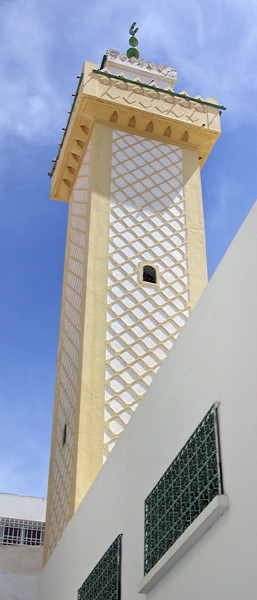
We were now in the area selling tinned goods and woven baskets as well as more clothes and shoes.
The area towards the Kasbah Mosque is residential. Plas de la Kasbah was full of stalls selling second hand clothes.



The Kasbah is in the south west corner of the Medina. It was built in 1849 and became the governor’s residence and HQ of the town militia. Now it is restored as the Museum of Traditional Architecture.


Steps lead up to the ramparts which give views along the Medina walls.

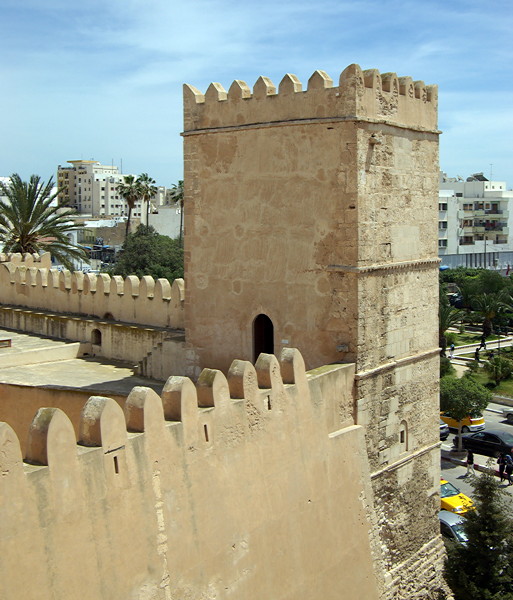


Rooms in the walls have exhibitions about the Kasbah and traditional houses including house plans. In part of the courtyard there is a display showing the different types of columns from different periods in history. Another display shows how the walls were built with strengthening tree trunks in them.

There is a colonnade which shows the different types of ceiling construction from arches to palm and citron wood which was popular as it didn’t rot.


The Medina sees few foreign tourists. There were a few bonjours from the shop keepers but no hassle or requests to look. There were no carpets or panoramic views. In fact there were few carpets and those were synthetic. It is a refreshing change after Tunis and Kairouran.
We walked past the wall of the Great Mosque with a few shuttered windows and no view of the minaret.
Beyond is Sidi Karray Mosque which has splendid doorways and windows.
We were now in the area selling tinned goods and woven baskets as well as more clothes and shoes.
The area towards the Kasbah Mosque is residential. Plas de la Kasbah was full of stalls selling second hand clothes.
The Kasbah is in the south west corner of the Medina. It was built in 1849 and became the governor’s residence and HQ of the town militia. Now it is restored as the Museum of Traditional Architecture.
Steps lead up to the ramparts which give views along the Medina walls.
Rooms in the walls have exhibitions about the Kasbah and traditional houses including house plans. In part of the courtyard there is a display showing the different types of columns from different periods in history. Another display shows how the walls were built with strengthening tree trunks in them.
There is a colonnade which shows the different types of ceiling construction from arches to palm and citron wood which was popular as it didn’t rot.
The Medina sees few foreign tourists. There were a few bonjours from the shop keepers but no hassle or requests to look. There were no carpets or panoramic views. In fact there were few carpets and those were synthetic. It is a refreshing change after Tunis and Kairouran.
Eleanor
1000+ Posts
Sfax - Museum of Popular Arts and Traditions
The Museum of Popular Arts and Traditions is on Dar Jeliouli, in ther residential part of the Medina. It has a splendid carved doorway in the centre of a lime washed wall with no windows. There is a small panel on the side of the door with opening times.

Through the doorway is a small dark vestibule with the ticket office . There is no brochure and they don’t sell post cards. There are labels in Arabic, French and English throughout the museum and a few paintings illustrating daily life.
Beyond is a dark hallway with seats which leads into the beautiful courtyard with decorative tiles and a wooden balcony round it. There is a well in one corner and very steep steps in the opposite corner lead to the underground storage area and cistern. Drainpipes from the roof have a small bowl for collecting water before it drains into the underground well.



The rooms off the courtyard are designed to give the impression that the house is still lived in. A large T shaped room on the left hand wall is set up as living area described as the ‘Tithkitha on Qbou salon’ with cushioned benches round the centre of the room and a small table. Above are pictures and a painted wooden shelf which was used to display precious belongings.


At one end is an alcove with a traditional bed with a small storage chest and a carved wooden screen in front of it.


At the opposite end are display cabinets with women’s head dresses, shoes and perfume vials. It is a very high room with windows at first floor level and a painted ceiling.
In the corner of the courtyard, steps lead down to the kitchen area which has a display of measures, bowls and dishes used for cooking, a still for extracting oils from flowers and a small traditional fire with a cooking pan above. Water colour paintings show how these were used.




Cont....
The Museum of Popular Arts and Traditions is on Dar Jeliouli, in ther residential part of the Medina. It has a splendid carved doorway in the centre of a lime washed wall with no windows. There is a small panel on the side of the door with opening times.
Through the doorway is a small dark vestibule with the ticket office . There is no brochure and they don’t sell post cards. There are labels in Arabic, French and English throughout the museum and a few paintings illustrating daily life.
Beyond is a dark hallway with seats which leads into the beautiful courtyard with decorative tiles and a wooden balcony round it. There is a well in one corner and very steep steps in the opposite corner lead to the underground storage area and cistern. Drainpipes from the roof have a small bowl for collecting water before it drains into the underground well.
The rooms off the courtyard are designed to give the impression that the house is still lived in. A large T shaped room on the left hand wall is set up as living area described as the ‘Tithkitha on Qbou salon’ with cushioned benches round the centre of the room and a small table. Above are pictures and a painted wooden shelf which was used to display precious belongings.
At one end is an alcove with a traditional bed with a small storage chest and a carved wooden screen in front of it.
At the opposite end are display cabinets with women’s head dresses, shoes and perfume vials. It is a very high room with windows at first floor level and a painted ceiling.
In the corner of the courtyard, steps lead down to the kitchen area which has a display of measures, bowls and dishes used for cooking, a still for extracting oils from flowers and a small traditional fire with a cooking pan above. Water colour paintings show how these were used.
Cont....
Eleanor
1000+ Posts
Sfax - Museum of Popular Arts and Traditions continued...
Next to this, opposite the hallway is a narrow room set up to demonstrate wood working techniques from the area. There is a foot operated spindle for carving wood and examples of decorative bed screens and chests to store valuables.
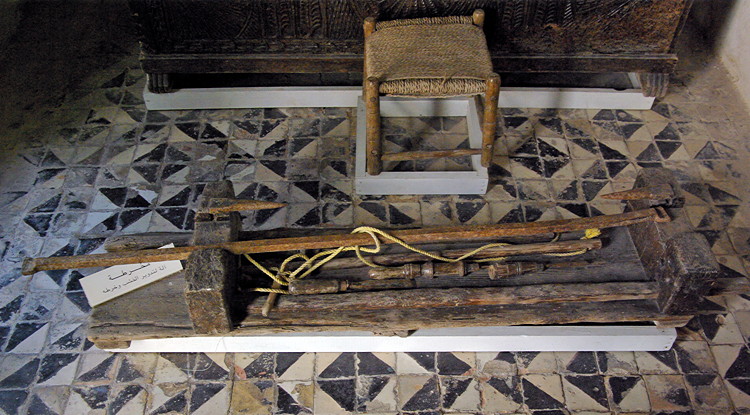


The room on the right side of the courtyard is a long narrow room with a painted ceiling with a traditional bed and screen at one end and a display case at the other with guns, powder container tamper etc. In the small recessed T area there is a small table with paintings and decorative shelf above.

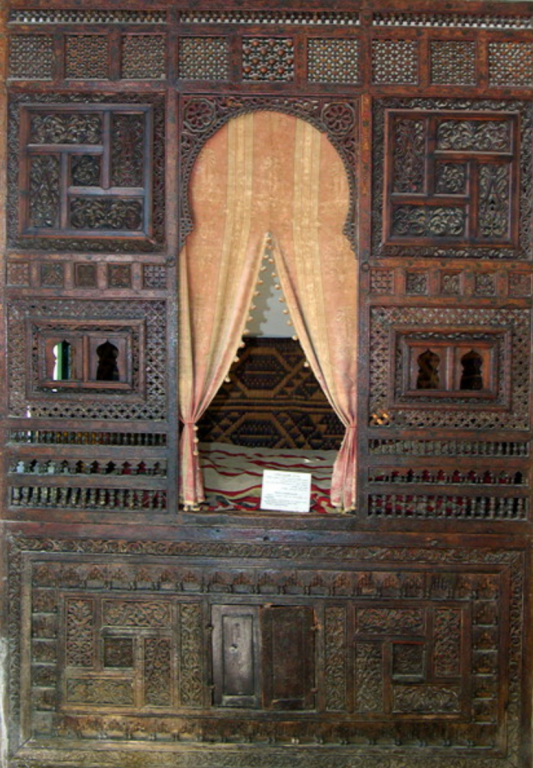
The room next to the hallway contains different examples of pottery storage jars from huge ones to store water to smaller ones for olive oil. These include a beautifully decorated yellow and green glazed jar with a fish and bird design which was used to store olives.

Stairs lead to a first floor corridor (with very dodgy toilet on the wall next to the roadway) and another set of stairs leads to the second floor balcony which runs round all four sides of the courtyard. The rooms up here are much simpler and have display cases with examples of traditional dress, jewellery which includes a splendid head dress hung with coins and shawls worn by the women.




One room has a display of Arab calligraphy and old paintings. There is a delightful pictures of the tomb of Sidi M’Hamed Ben Aissa guarded by “dangerous animals” which included lions, snakes and scorpions.



It was a very well worth while visit and for most of the time we were the only visitors.
Next to this, opposite the hallway is a narrow room set up to demonstrate wood working techniques from the area. There is a foot operated spindle for carving wood and examples of decorative bed screens and chests to store valuables.
The room on the right side of the courtyard is a long narrow room with a painted ceiling with a traditional bed and screen at one end and a display case at the other with guns, powder container tamper etc. In the small recessed T area there is a small table with paintings and decorative shelf above.
The room next to the hallway contains different examples of pottery storage jars from huge ones to store water to smaller ones for olive oil. These include a beautifully decorated yellow and green glazed jar with a fish and bird design which was used to store olives.
Stairs lead to a first floor corridor (with very dodgy toilet on the wall next to the roadway) and another set of stairs leads to the second floor balcony which runs round all four sides of the courtyard. The rooms up here are much simpler and have display cases with examples of traditional dress, jewellery which includes a splendid head dress hung with coins and shawls worn by the women.
One room has a display of Arab calligraphy and old paintings. There is a delightful pictures of the tomb of Sidi M’Hamed Ben Aissa guarded by “dangerous animals” which included lions, snakes and scorpions.
It was a very well worth while visit and for most of the time we were the only visitors.
Eleanor
1000+ Posts
Elles Tombs
Elles Tombs don’t figure in the guide books and there when we visited, there was very little about them on the web. What we could find, we liked the sound of.
Elles is a short drive from Maktar. It is a small village of typical Tunisian houses with white painted walls and flat roofs. Chickens run freely round the village and donkeys are still the main method of transport.
There are over 70 megalithic tombs from the Punic period (C2nd BC) scattered across the landscape. The exact number is uncertain as many tombs have collapsed leaving a pile of rocks in an already rocky landscape. More are still being discovered.
The best preserved tomb (number 16) is in the village and has a parking area with a small building with very basic toilet (and I do mean very), ticket office and a few finds from round the site.


The tomb is asymmetrical. On one side there are large upright slabs and on the other it is built up with a series of steps made up of small stones to give it stability. The top is covered with a series of massive slabs. Inside are seven chambers.


This is one of the few tombs visitors can enter.


There are many more tombs scattered across the hillside behind the hut, each with the same basic design and in different states of preservation.






This is a beautiful place with bare limestone hills with eroded sloping strata and pine trees. There are scattered farm buildings and some wheat being grown. At the end of March there were wild flowers everywhere, marigolds, ragwort, poppies, charlock, anemones, wild peas…We really enjoyed it.

As well as the tombs at Elles we also passed more a few miles away on the hillside above the river valley. Our guide said this was called Zawkriya, but we couldn’t find this marked on the map and nothing about these tombs. Again proof that Tunisia is stuffed with archaeological remains just waiting to be discovered.
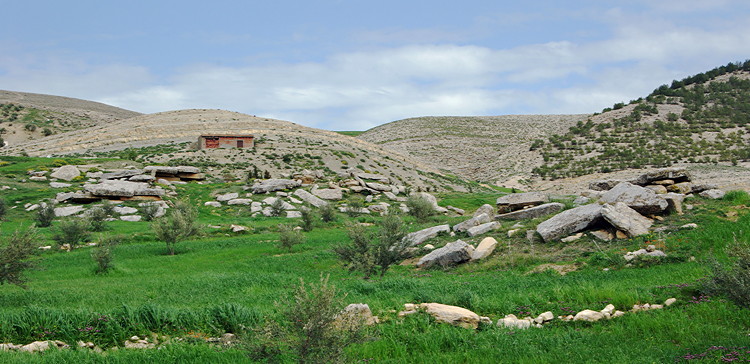
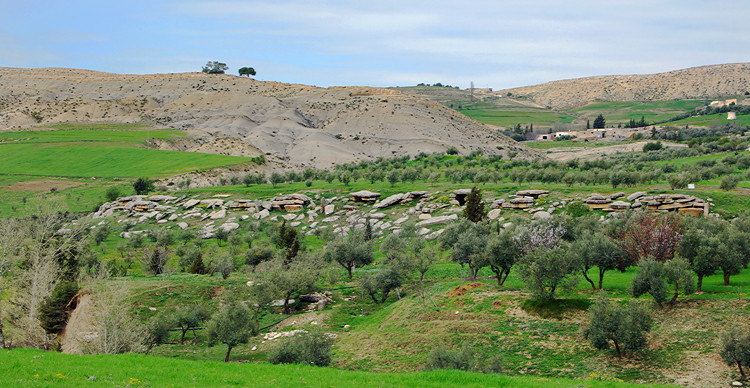

Elles Tombs don’t figure in the guide books and there when we visited, there was very little about them on the web. What we could find, we liked the sound of.
Elles is a short drive from Maktar. It is a small village of typical Tunisian houses with white painted walls and flat roofs. Chickens run freely round the village and donkeys are still the main method of transport.
There are over 70 megalithic tombs from the Punic period (C2nd BC) scattered across the landscape. The exact number is uncertain as many tombs have collapsed leaving a pile of rocks in an already rocky landscape. More are still being discovered.
The best preserved tomb (number 16) is in the village and has a parking area with a small building with very basic toilet (and I do mean very), ticket office and a few finds from round the site.
The tomb is asymmetrical. On one side there are large upright slabs and on the other it is built up with a series of steps made up of small stones to give it stability. The top is covered with a series of massive slabs. Inside are seven chambers.
This is one of the few tombs visitors can enter.
There are many more tombs scattered across the hillside behind the hut, each with the same basic design and in different states of preservation.
This is a beautiful place with bare limestone hills with eroded sloping strata and pine trees. There are scattered farm buildings and some wheat being grown. At the end of March there were wild flowers everywhere, marigolds, ragwort, poppies, charlock, anemones, wild peas…We really enjoyed it.
As well as the tombs at Elles we also passed more a few miles away on the hillside above the river valley. Our guide said this was called Zawkriya, but we couldn’t find this marked on the map and nothing about these tombs. Again proof that Tunisia is stuffed with archaeological remains just waiting to be discovered.
Last edited:
Eleanor
1000+ Posts
Jugurtha’s Table
Jugurtha’s Table is a mighty hilltop fortress with amazing views near the Algerian border. It is a couple of hours drive south of El Kef.
It rises steep out of the plain with sheer cliffs standing 200m high. It looks impregnable. The sandstone rock appears gold and red in the sunshine and has deeply eroded gullies in it with a jumble of huge broken boulders at the bottom. To say it is impressive is an understatement.

The top of Jugurtha’s Table was covered in cloud when we first saw it rising vertically out of the plain. Our heart’s sank, however from the first sight it takes quite a long time to reach the base and the clouds slowly began to roll back.

This area is close to the Algerian Border so there were many police check points and we had to show passports and say where we were going.
There is quite a bit of settlement on the slopes below the Table with a network of rough tracks. It is a mix of typical Tunisian housing with flat roofs and what the Tunisians describe a ‘French’ with red tiled roofs designed to throw off winter snows.
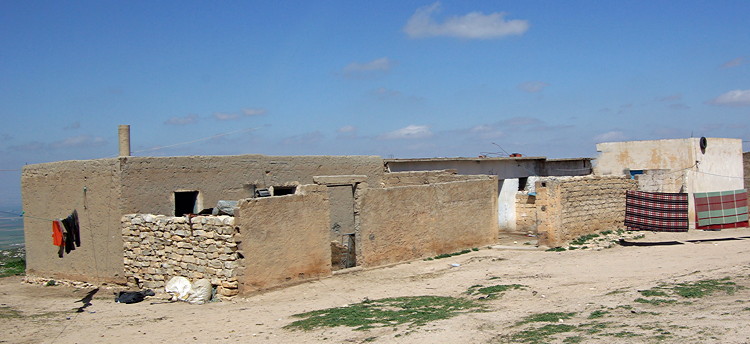

Our driver kept stopping to check on the route as the track climbed and swung round bottom of Jugurtha’s Table past fields covered in small wild Narcissus.


By now cloud had lifted and we could see the top was a large flat plateau which was very narrow at the end.

Jugurtha’s Table is named after the Numidian, King Jugurtha, who used it as an impregnable fortress in his campaign against the Romans who were led by Marius. There are the remains of walls and buildings at the bottom of the Table. On an old map these are marked as the Campe de Commandement de Marius. Further round the mass of rocks at bottom with what looked like more old settlements have rocks cleared from land to make field boundaries.

Cont....
Jugurtha’s Table is a mighty hilltop fortress with amazing views near the Algerian border. It is a couple of hours drive south of El Kef.
It rises steep out of the plain with sheer cliffs standing 200m high. It looks impregnable. The sandstone rock appears gold and red in the sunshine and has deeply eroded gullies in it with a jumble of huge broken boulders at the bottom. To say it is impressive is an understatement.
The top of Jugurtha’s Table was covered in cloud when we first saw it rising vertically out of the plain. Our heart’s sank, however from the first sight it takes quite a long time to reach the base and the clouds slowly began to roll back.
This area is close to the Algerian Border so there were many police check points and we had to show passports and say where we were going.
There is quite a bit of settlement on the slopes below the Table with a network of rough tracks. It is a mix of typical Tunisian housing with flat roofs and what the Tunisians describe a ‘French’ with red tiled roofs designed to throw off winter snows.
Our driver kept stopping to check on the route as the track climbed and swung round bottom of Jugurtha’s Table past fields covered in small wild Narcissus.
By now cloud had lifted and we could see the top was a large flat plateau which was very narrow at the end.
Jugurtha’s Table is named after the Numidian, King Jugurtha, who used it as an impregnable fortress in his campaign against the Romans who were led by Marius. There are the remains of walls and buildings at the bottom of the Table. On an old map these are marked as the Campe de Commandement de Marius. Further round the mass of rocks at bottom with what looked like more old settlements have rocks cleared from land to make field boundaries.
Cont....
Last edited:
Eleanor
1000+ Posts
Jugurtha’s Table continued...
There is a small parking area at base of steps which are the only way to reach the top. These scramble up a narrow gully. The bottom of steps are well made and fairly new. They lead to modern stone gateway which replaces the original which had a sturdy wooden door that could be closed at night. Above there is an area of polished limestone to scramble up with the aid of a metal handrail, not as bad as it looked, although I would not want to attempt it if the rock was wet. Then another flight of older and less well made steps to top. It was a much easier climb than expected after reading stories of hands and knees scramble.

The top covers a massive area and was bright yellow with wild flowers. There is an area of cave settlements at the top of the steps.

Near are the remains of a substantial village.



A small white Marabout was built about 1912 and contains the tomb of Sidi Abdyawad. This is surrounded by a wall with a door which is locked unless the site guardian is around. The police had phoned him to tell him tourists were on the way to Jugurtha’s Table and he appeared to let us in. Inside were two large tombs covered with material and some old wall hangings.


The top of the plateau is limestone and a large reservoir was cut into the top of the rock by the Numidians which was full and contained a good growth of pond weed.


Close by was another less well formed pool, with areas which looked as if stone blacks had been quarried.

In one place there was what looked like a game carved in the rock

Several horses grazing at one end of plateau. We wondered how they had got up there.
It was too hazy for good distant views, which were fairly flat with distant mountains, some of which were also flat topped like Jugurtha’s Table. We could see into Algeria. It is a delightful place which we had to ourselves and we could happily have spent a whole day wandering around the top.



Back at car park, we took a road which continued round the bottom of the mountain back to the village. This was being widened and improved in 2012 as there had been talk of taking coaches to Jugurtha’s Table. Is this another example of tourism spoiling a place by making it too accessible to tourists? It isn’t as impressive a drive as the older route, so if you have the choice opt for that one.
There is a small parking area at base of steps which are the only way to reach the top. These scramble up a narrow gully. The bottom of steps are well made and fairly new. They lead to modern stone gateway which replaces the original which had a sturdy wooden door that could be closed at night. Above there is an area of polished limestone to scramble up with the aid of a metal handrail, not as bad as it looked, although I would not want to attempt it if the rock was wet. Then another flight of older and less well made steps to top. It was a much easier climb than expected after reading stories of hands and knees scramble.
The top covers a massive area and was bright yellow with wild flowers. There is an area of cave settlements at the top of the steps.
Near are the remains of a substantial village.
A small white Marabout was built about 1912 and contains the tomb of Sidi Abdyawad. This is surrounded by a wall with a door which is locked unless the site guardian is around. The police had phoned him to tell him tourists were on the way to Jugurtha’s Table and he appeared to let us in. Inside were two large tombs covered with material and some old wall hangings.
The top of the plateau is limestone and a large reservoir was cut into the top of the rock by the Numidians which was full and contained a good growth of pond weed.
Close by was another less well formed pool, with areas which looked as if stone blacks had been quarried.
In one place there was what looked like a game carved in the rock
Several horses grazing at one end of plateau. We wondered how they had got up there.
It was too hazy for good distant views, which were fairly flat with distant mountains, some of which were also flat topped like Jugurtha’s Table. We could see into Algeria. It is a delightful place which we had to ourselves and we could happily have spent a whole day wandering around the top.
Back at car park, we took a road which continued round the bottom of the mountain back to the village. This was being widened and improved in 2012 as there had been talk of taking coaches to Jugurtha’s Table. Is this another example of tourism spoiling a place by making it too accessible to tourists? It isn’t as impressive a drive as the older route, so if you have the choice opt for that one.
Eleanor
1000+ Posts
Kesra
Kesra is a small traditional village a few miles east of Maktar. When we visited in 2012, Kesra was ignored by the guide books. Apart from a waterfall which cascades down a rock face and is a popular place for locals to enjoy themselves, the only reason to stop in Kesra is to visit the newly opened Museum in the Old town. Were were the only non-Tunisians.
The old Berber town stands on top of the cliff above the waterfall. At just over 3000’, it is Tunisia’s highest town.
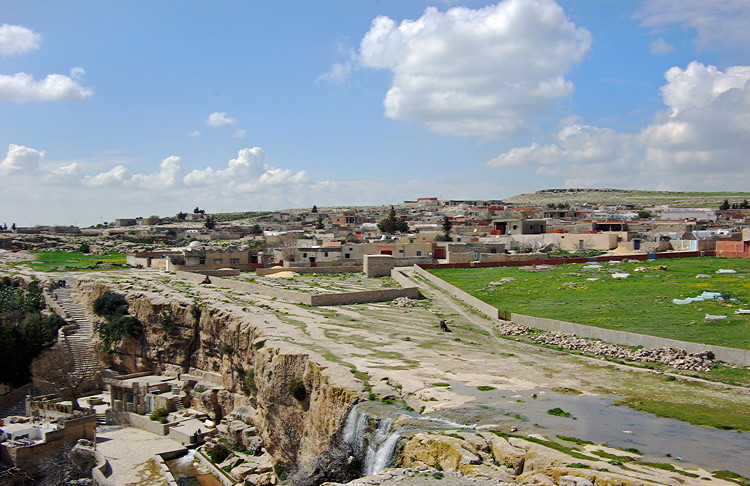


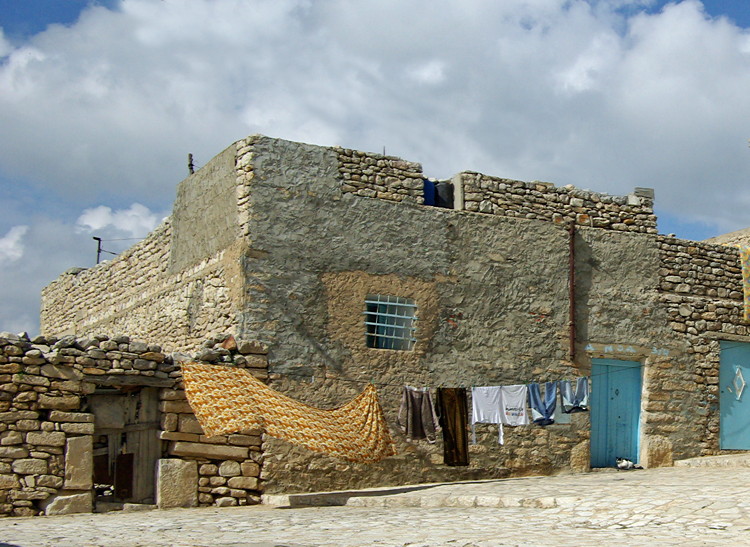
A pool had been built at the base of the waterfall which was a source of water for washing by the locals.
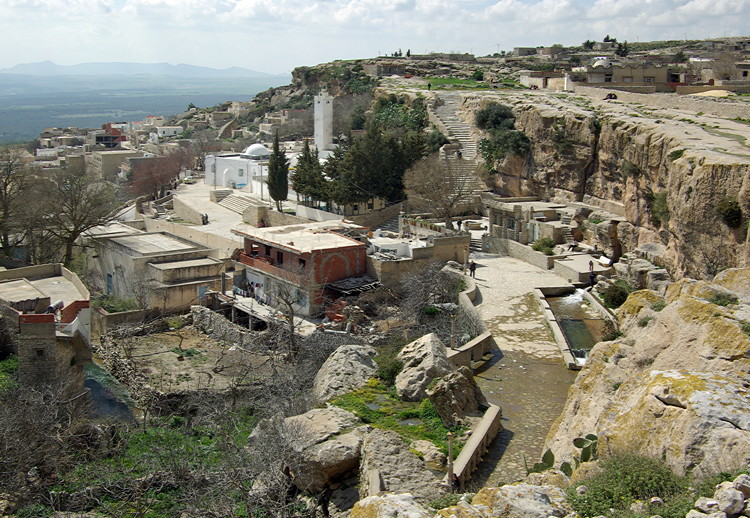
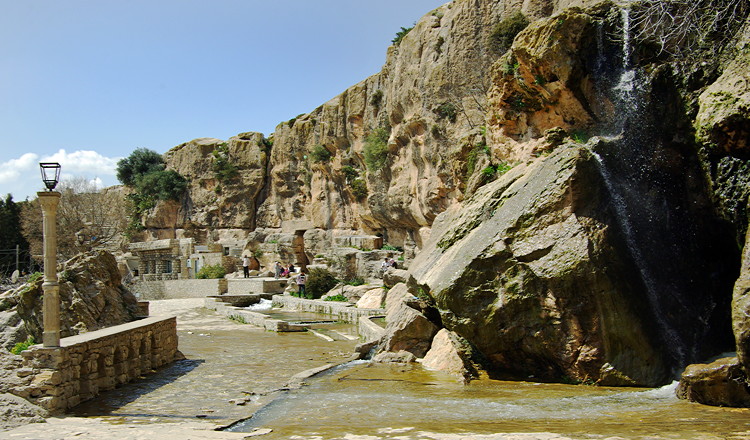
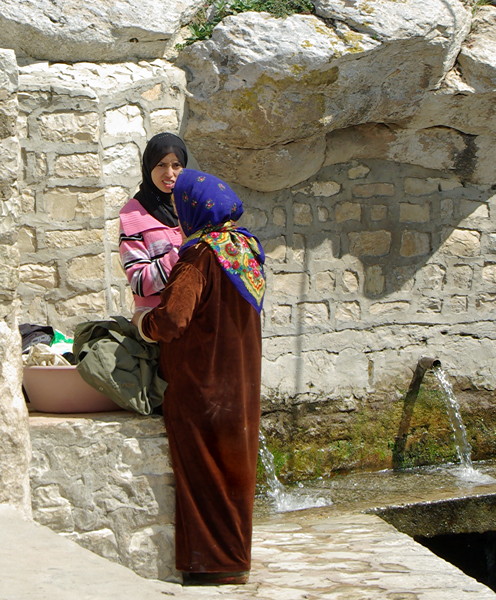
More were using the ford above the waterfall.


Kesra was probably a strategic site and there are the remains of is described as a Byzantine town wall around the old settlement at the top of the hill.

Kesra is a small traditional village a few miles east of Maktar. When we visited in 2012, Kesra was ignored by the guide books. Apart from a waterfall which cascades down a rock face and is a popular place for locals to enjoy themselves, the only reason to stop in Kesra is to visit the newly opened Museum in the Old town. Were were the only non-Tunisians.
The old Berber town stands on top of the cliff above the waterfall. At just over 3000’, it is Tunisia’s highest town.
A pool had been built at the base of the waterfall which was a source of water for washing by the locals.
More were using the ford above the waterfall.
Kesra was probably a strategic site and there are the remains of is described as a Byzantine town wall around the old settlement at the top of the hill.
Last edited:
Eleanor
1000+ Posts
Kesra - Museum of Traditional Patrimony
The museum, opened in 2009 in a building in the old town, concentrates on the traditional role of women in Tunisian society. It has labels in Arabic, French and English. It gets very few visitors which is a shame as we thoroughly enjoyed the visit and learned a lot.
There are several well laid out rooms on the ground floor. When we visited, the upstairs had a display of a few pictures from the area and can be missed.
There are display cases of cooking utensils with jugs, dishes and plates.


Next to these is a reconstruction of a summer kitchen with equipment used.

This included a brazier (kanoun) with bowl (borma) above used to cook meat and vegetables and Keskés above in which coucous was steamed. A sheepskin hanging up (chekwa) was used to make buttermilk.

There is bread needing bowl as well as a wooden chopping block, pestle and mortar and a hand quern.


In another case is a display of clothing including the qacchabiya which was a winter coat made from a single piece of cloth with a hood. There are examples of the tools used in washing, carding and spinning wool.


The display on weddings includes examples of wedding clothes and the contents of the Alegua which was given by the groom’s mother to the bride before the wedding and contained the ingredients needed to decorate her hands with henna. There are Korsi baskets which were used to collect donations before the wedding.




There are a couple of cases with examples of jewellery which included silver anklets and earrings.


There is a display on circumcision, information on warding off the evil eye and death rituals, including a set of funeral clothes.

There is still little information about the museum - a brief sentence in Lonely Planet - and an article in Journal Museum International in 2018.
Kesra can be visited in a day from Kairouan, especially if linked in with a visit to Maktar.
The museum, opened in 2009 in a building in the old town, concentrates on the traditional role of women in Tunisian society. It has labels in Arabic, French and English. It gets very few visitors which is a shame as we thoroughly enjoyed the visit and learned a lot.
There are several well laid out rooms on the ground floor. When we visited, the upstairs had a display of a few pictures from the area and can be missed.
There are display cases of cooking utensils with jugs, dishes and plates.
Next to these is a reconstruction of a summer kitchen with equipment used.
This included a brazier (kanoun) with bowl (borma) above used to cook meat and vegetables and Keskés above in which coucous was steamed. A sheepskin hanging up (chekwa) was used to make buttermilk.
There is bread needing bowl as well as a wooden chopping block, pestle and mortar and a hand quern.
In another case is a display of clothing including the qacchabiya which was a winter coat made from a single piece of cloth with a hood. There are examples of the tools used in washing, carding and spinning wool.
The display on weddings includes examples of wedding clothes and the contents of the Alegua which was given by the groom’s mother to the bride before the wedding and contained the ingredients needed to decorate her hands with henna. There are Korsi baskets which were used to collect donations before the wedding.
There are a couple of cases with examples of jewellery which included silver anklets and earrings.
There is a display on circumcision, information on warding off the evil eye and death rituals, including a set of funeral clothes.
There is still little information about the museum - a brief sentence in Lonely Planet - and an article in Journal Museum International in 2018.
Kesra can be visited in a day from Kairouan, especially if linked in with a visit to Maktar.
Last edited:
Eleanor
1000+ Posts
Ksar Ezzit - an organic olive farm
Ksar Ezzit is an organic olive farm in the mountains south of Zaghouan, which also has accommodation in small villas scattered around the property. Many of these are based on traditional Tunisian buildings.

When we were planning the holiday in 2010, we were told this was an exciting new development in Tunisian eco-tourism. There were talks and activities on aspects of the farm as well as horse riding and guided nature walks. There was also chance to visit nearby sites including cave painting sites, Zaghouan etc. It sounded great so we booked 3 nights there.
When we got the final itinerary through a month before the holiday, the visits to local sites were no longer mentioned. There was no mention of activities on the web site apart from horse riding and walking. That should have set warning bells ringing but didn’t. Although our driver wasn’t allocated to us during our stay in Ksar Ezzit, he kept asking us whether we wanted him to come each day to take us out. We assured him that wasn’t necessary as we had been told ‘all optional activities included’.
We arrived with high hopes. It is in a delightful setting with hills on three sides and extensive views across the plain to the north. There are 80,000 olive trees and wild flowers were everywhere. Security at the gate was tight and involved a series of phone calls before we were let through. It was then a couple of miles drive to reception. On the way we passed signs pointing in different directions to ‘restaurant’ and ‘reception’. Warning bells now began to ring especially as almost the first comment was ‘you don’t have a car with you?’ There was no mention of ‘activities’. We had been expecting to be given a list of options to choose from. We filled in the necessary forms and waved goodbye to our driver who was so concerned about us drove to the restaurant to check how far it was - 3.2km.
We were in Villa Huilerie which was opposite the reception block, stables and the area where the cows were kept at night. There were guinea fowl and chickens running around outside including several cockerels which began to crow from 3am. It was huge with a large living room with one way glass window overlooking an old olive press. This is no longer used and the area washing used as a gift shop. The bedroom was a triumph of design over functionality with little space to put things but the bed was very comfortable. Even though we had full board and ate in the restaurant, there was a small kitchen with plenty of crockery but no cooking utensils.
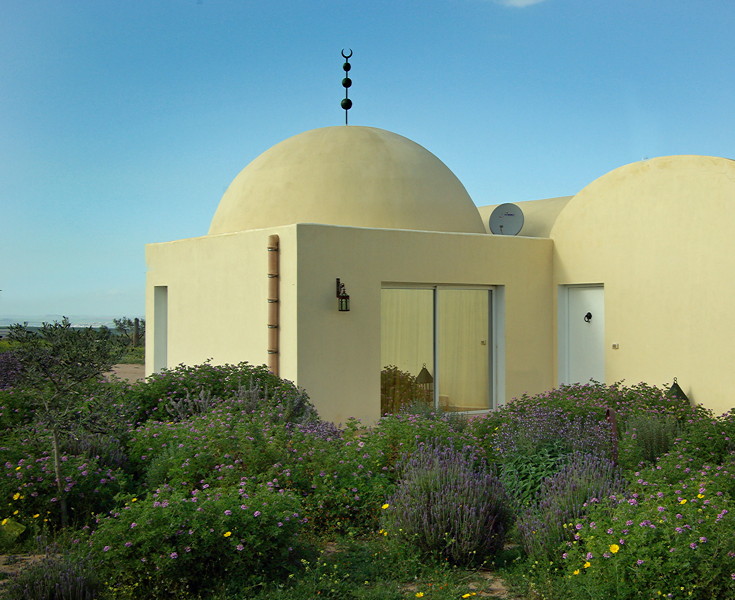


Breakfasts were excellent self service buffets with plenty of choice. Lunch and dinner consisted of 5 courses, starter, a salad, soup, another salad, meat course and finally fresh fruit washed down with what we think was ginger tea. The salads often consisted of leaves and flowers growing wild on the farm. Michael described it as a sort of nouvelle cuisine meets ‘Gardener’s World’. Soups were invariably good. Main courses were rather thin and a bit strange. We are sure it was lamb’s knee caps one night… The fresh fruit was always reliable and welcome.


Once Ksar Ezzit got over the shock of the arrival of two carless visitors, everything worked well. Mahommed gave us a lift to and from the restaurant in a very dusty and battered Passat. He made sure the car headlights were left on so we could find our way back to the villa after dinner.
We spent a couple of days wandering round the estate by ourselves. There are tracks to follow through the olive groves.



We saw the horses out grazing who looked very frisky and made off at our approach. We found two lots of beehives, used to make their own honey. We also found the ruins of the building which housed a 300 year old olive press and looked very derelict in 2012.
We could hear but not see the tractor ploughing between the olives and watched women hand cutting the vegetation growing beneath the olive trees. Unlike many other parts of Tunisia, Ksar Ezzit do not grow vegetables under the olive trees as they believe it adversely affects the flavour of the olives. The farm vegetables are grown well away from the olives. Lavender bushes are planted between the young trees which is supposed to improve the flavour of the olives. They were in flower in early April. Otherwise the land is left fallow and the weeds harvested for animal fodder.

The soil looked very dry and stoney in places. The olives are irrigated during the summer. In April the vegetation was very lush and up to 2’ high, although subsequent growth after cutting is less high. There were wild flowers everywhere, even Michael was enthusing. Some I could recognise but there were many I couldn’t.


All morning we were accompanied by the sound of bird song, including a cuckoo. It was good to be out in the fresh air and sunshine and we enjoyed ourselves.
Cont....
Ksar Ezzit is an organic olive farm in the mountains south of Zaghouan, which also has accommodation in small villas scattered around the property. Many of these are based on traditional Tunisian buildings.
When we were planning the holiday in 2010, we were told this was an exciting new development in Tunisian eco-tourism. There were talks and activities on aspects of the farm as well as horse riding and guided nature walks. There was also chance to visit nearby sites including cave painting sites, Zaghouan etc. It sounded great so we booked 3 nights there.
When we got the final itinerary through a month before the holiday, the visits to local sites were no longer mentioned. There was no mention of activities on the web site apart from horse riding and walking. That should have set warning bells ringing but didn’t. Although our driver wasn’t allocated to us during our stay in Ksar Ezzit, he kept asking us whether we wanted him to come each day to take us out. We assured him that wasn’t necessary as we had been told ‘all optional activities included’.
We arrived with high hopes. It is in a delightful setting with hills on three sides and extensive views across the plain to the north. There are 80,000 olive trees and wild flowers were everywhere. Security at the gate was tight and involved a series of phone calls before we were let through. It was then a couple of miles drive to reception. On the way we passed signs pointing in different directions to ‘restaurant’ and ‘reception’. Warning bells now began to ring especially as almost the first comment was ‘you don’t have a car with you?’ There was no mention of ‘activities’. We had been expecting to be given a list of options to choose from. We filled in the necessary forms and waved goodbye to our driver who was so concerned about us drove to the restaurant to check how far it was - 3.2km.
We were in Villa Huilerie which was opposite the reception block, stables and the area where the cows were kept at night. There were guinea fowl and chickens running around outside including several cockerels which began to crow from 3am. It was huge with a large living room with one way glass window overlooking an old olive press. This is no longer used and the area washing used as a gift shop. The bedroom was a triumph of design over functionality with little space to put things but the bed was very comfortable. Even though we had full board and ate in the restaurant, there was a small kitchen with plenty of crockery but no cooking utensils.
Breakfasts were excellent self service buffets with plenty of choice. Lunch and dinner consisted of 5 courses, starter, a salad, soup, another salad, meat course and finally fresh fruit washed down with what we think was ginger tea. The salads often consisted of leaves and flowers growing wild on the farm. Michael described it as a sort of nouvelle cuisine meets ‘Gardener’s World’. Soups were invariably good. Main courses were rather thin and a bit strange. We are sure it was lamb’s knee caps one night… The fresh fruit was always reliable and welcome.
Once Ksar Ezzit got over the shock of the arrival of two carless visitors, everything worked well. Mahommed gave us a lift to and from the restaurant in a very dusty and battered Passat. He made sure the car headlights were left on so we could find our way back to the villa after dinner.
We spent a couple of days wandering round the estate by ourselves. There are tracks to follow through the olive groves.
We saw the horses out grazing who looked very frisky and made off at our approach. We found two lots of beehives, used to make their own honey. We also found the ruins of the building which housed a 300 year old olive press and looked very derelict in 2012.
We could hear but not see the tractor ploughing between the olives and watched women hand cutting the vegetation growing beneath the olive trees. Unlike many other parts of Tunisia, Ksar Ezzit do not grow vegetables under the olive trees as they believe it adversely affects the flavour of the olives. The farm vegetables are grown well away from the olives. Lavender bushes are planted between the young trees which is supposed to improve the flavour of the olives. They were in flower in early April. Otherwise the land is left fallow and the weeds harvested for animal fodder.
The soil looked very dry and stoney in places. The olives are irrigated during the summer. In April the vegetation was very lush and up to 2’ high, although subsequent growth after cutting is less high. There were wild flowers everywhere, even Michael was enthusing. Some I could recognise but there were many I couldn’t.
All morning we were accompanied by the sound of bird song, including a cuckoo. It was good to be out in the fresh air and sunshine and we enjoyed ourselves.
Cont....
Eleanor
1000+ Posts
Ksar Ezzit Continued - Activities
Ksar Ezzit did provide activities for us. We were shown the 80 year old olive press in the big room next to reception which is still used to press the olives. A large stone roller is worked by belts driven by a steam piston engine. The ground olives are put into straw baskets which are piled up in the presses which are squeezed by a big pile of weights. The best oil is collected in the first 60 minutes. Otherwise the olives are pressed for 24 hours. The oil is collected in large white tile tanks which allow the water to settle out.




Two short short excursions were arranged for us. Talking to the manager in the restaurant he had found out that we were interested in the Roman sites and he arranged for us to be taken to the remains of Abthugni and Zaghouan in the morning. (Both places are described in more detail in the Trip Report covering teh Roman Remains in the north of Tunisia.)
We set off with Mohammed and a driver in a 4x4. Abthugni is near the modern village of Henchir es-Souar, off the Tunis to Kairouan road. It isn’t marked on any of the maps and there is very little information about it on the web. A series of small settlements are built above the road along the spring line. Henchir es-Souar, is one of these. It is a lovely site at the base of the mountains with a few houses scattered over the landscape with a small school next to the Roman remains. There are no signs or information. All that is left is a paved forum with steps up to the remains of the Capitol on a huge plinth with the remains of underground rooms underneath. Opposite the capitol, an offset archway leads to another paved area with the remains of a few walls. Apart from a shepherd with a small flock of sheep we were the only people around.


It is a nice run to through El Fahs to Zaghouan through very fertile countryside with wheat, olives and vines. A narrow street leads to Temples des Eaux which supplied the water to Tunis by aqueduct. It is a beautiful site at the base of the mountain above the town with a park with trees, grass and a cafe.

We stopped in El Fahs on the way back. It was market day and chaos with double parking along the street with barely room for one car to get through. There were several stand-offs when cars coming from opposite directions wouldn’t give way and traffic ground to a halt. There were pick ups loaded with sheep. The market square is a large open area surrounded by fruit and vegetable stalls and butcher’s stalls with cows heads, lungs, intestines and sheep carcasses hanging up. Mohamed went to buy cigarettes for the manager and reappeared with small bag of chicken. The driver came back with two big bags of vegetables.
After lunch Mahommed took us to the lake in the valley next to Ksar Ezzit. It was a nice drive climbing up through wheat fields and olive groves with splendid views across the valley to Ksar Ezzit. A rough road drops down across the dam. There was a shepherd with big flock of sheep and three very fierce dogs who didn’t like the look of us. Ksar Ezzit rents water from the lake which is pumped to irrigate olives.
We were told that today’s excursions were a ‘gift’ from Ksar Ezzit and we would normally have to pay. We told him our understanding was that all optional activities were included but Mohammed said no. This explains his surprise/concern when we arrived without a car.
We think Ksar Ezzit may have intended, or even begun, offering activities and excursions but found that the idea didn’t catch on. We later found out that many wealthy Tunisians go and stop at Ksar Ezzit with their own cars and would not want included activities.
Despite the problems and niggles we enjoyed our stay. Ksar Ezzit does have a lot going for it. It is a delightful place to drop out and do nothing. There was a swimming pool fed by natural spring water with a slight algal growth on the bottom and frogs which may not suit everyone.

Anyone visiting does need to be very clear what is or isn’t provided and do ideally need a 4x4 with them.
Ksar Ezzit did provide activities for us. We were shown the 80 year old olive press in the big room next to reception which is still used to press the olives. A large stone roller is worked by belts driven by a steam piston engine. The ground olives are put into straw baskets which are piled up in the presses which are squeezed by a big pile of weights. The best oil is collected in the first 60 minutes. Otherwise the olives are pressed for 24 hours. The oil is collected in large white tile tanks which allow the water to settle out.
Two short short excursions were arranged for us. Talking to the manager in the restaurant he had found out that we were interested in the Roman sites and he arranged for us to be taken to the remains of Abthugni and Zaghouan in the morning. (Both places are described in more detail in the Trip Report covering teh Roman Remains in the north of Tunisia.)
We set off with Mohammed and a driver in a 4x4. Abthugni is near the modern village of Henchir es-Souar, off the Tunis to Kairouan road. It isn’t marked on any of the maps and there is very little information about it on the web. A series of small settlements are built above the road along the spring line. Henchir es-Souar, is one of these. It is a lovely site at the base of the mountains with a few houses scattered over the landscape with a small school next to the Roman remains. There are no signs or information. All that is left is a paved forum with steps up to the remains of the Capitol on a huge plinth with the remains of underground rooms underneath. Opposite the capitol, an offset archway leads to another paved area with the remains of a few walls. Apart from a shepherd with a small flock of sheep we were the only people around.
It is a nice run to through El Fahs to Zaghouan through very fertile countryside with wheat, olives and vines. A narrow street leads to Temples des Eaux which supplied the water to Tunis by aqueduct. It is a beautiful site at the base of the mountain above the town with a park with trees, grass and a cafe.
We stopped in El Fahs on the way back. It was market day and chaos with double parking along the street with barely room for one car to get through. There were several stand-offs when cars coming from opposite directions wouldn’t give way and traffic ground to a halt. There were pick ups loaded with sheep. The market square is a large open area surrounded by fruit and vegetable stalls and butcher’s stalls with cows heads, lungs, intestines and sheep carcasses hanging up. Mohamed went to buy cigarettes for the manager and reappeared with small bag of chicken. The driver came back with two big bags of vegetables.
After lunch Mahommed took us to the lake in the valley next to Ksar Ezzit. It was a nice drive climbing up through wheat fields and olive groves with splendid views across the valley to Ksar Ezzit. A rough road drops down across the dam. There was a shepherd with big flock of sheep and three very fierce dogs who didn’t like the look of us. Ksar Ezzit rents water from the lake which is pumped to irrigate olives.
We were told that today’s excursions were a ‘gift’ from Ksar Ezzit and we would normally have to pay. We told him our understanding was that all optional activities were included but Mohammed said no. This explains his surprise/concern when we arrived without a car.
We think Ksar Ezzit may have intended, or even begun, offering activities and excursions but found that the idea didn’t catch on. We later found out that many wealthy Tunisians go and stop at Ksar Ezzit with their own cars and would not want included activities.
Despite the problems and niggles we enjoyed our stay. Ksar Ezzit does have a lot going for it. It is a delightful place to drop out and do nothing. There was a swimming pool fed by natural spring water with a slight algal growth on the bottom and frogs which may not suit everyone.
Anyone visiting does need to be very clear what is or isn’t provided and do ideally need a 4x4 with them.
How to Find Information
Search using the search button in the upper right. Search all forums or current forum by keyword or member. Advanced search gives you more options.
Filter forum threads using the filter pulldown above the threads. Filter by prefix, member, date. Or click on a thread title prefix to see all threads with that prefix.
Recommended Guides, Apps and Books
52 Things to See and Do in Basilicata by Valerie Fortney Italian Ancestral Journeys by Bryan Schneider Italian Food & Life Rules by Ann Reavis Italian Food Decoder App by Dana Facaros, Michael Pauls French Food Decoder App by Dana Facaros, Michael Pauls She Left No Note, Lake Iseo Italy Mystery 1 by J L Crellina Tuscan Traveler, Living in Italy by Ann Reavis
